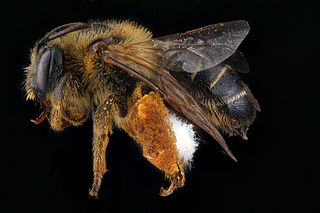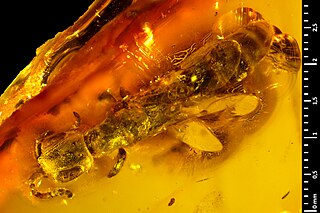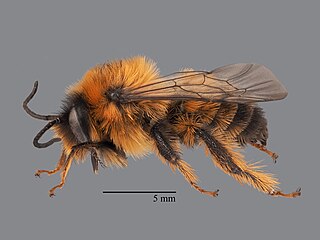
Bees are winged insects closely related to wasps and ants, known for their roles in pollination and, in the case of the best-known bee species, the western honey bee, for producing honey. Bees are a monophyletic lineage within the superfamily Apoidea. They are currently considered a clade, called Anthophila. There are over 20,000 known species of bees in seven recognized biological families. Some species – including honey bees, bumblebees, and stingless bees – live socially in colonies while most species (>90%) – including mason bees, carpenter bees, leafcutter bees, and sweat bees – are solitary.

Halictidae is the second-largest family of bees with nearly 4,500 species. They are commonly called sweat bees, as they are often attracted to perspiration. Halictid species are an extremely diverse group that can vary greatly in appearance. These bees occur all over the world and are found on every continent except Antarctica. Usually dark-colored and often metallic, halictids are found in various sizes, colors and patterns. Several species are all or partly green and a few are red, purple, or blue. A number of them have yellow markings, especially the males, which commonly have yellow faces, a pattern widespread among the various families of bees. The family is one of many with short tongues and is best distinguished by the arcuate basal vein found on the wing. Females in this family tend to be larger than the males. They are the group for which the term 'eusocial' was first coined by entomologist, Suzanne Batra.

The term cuckoo bee is used for a variety of different bee lineages which have evolved the kleptoparasitic behaviour of laying their eggs in the nests of other bees, reminiscent of the behavior of cuckoo birds. The name is perhaps best applied to the apid subfamily Nomadinae, but is commonly used in Europe to mean bumblebees Bombus subgenus Psithyrus. Females of cuckoo bees are easy to recognize in almost all cases, as they lack pollen-collecting structures and do not construct their own nests. They often have reduced body hair, abnormally thick and/or heavily sculptured exoskeleton, and saber-like mandibles, although this is not universally true; other less visible changes are also common.

The Apinae are the subfamily that includes the majority of bees in the family Apidae. It includes the familiar "corbiculate" bees—bumblebees, honey bees, orchid bees, stingless bees, Africanized bees, and the extinct genus Euglossopteryx. It also includes all but two of the groups that were previously classified in the family Anthophoridae.

The Andrenidae are a large, nearly cosmopolitan family of solitary, ground-nesting bees. Most of the family's diversity is located in temperate or arid areas. It includes some enormous genera. One of the subfamilies, Oxaeinae, is so different in appearance that they were typically accorded family status, but careful phylogenetic analysis reveals them to be an offshoot within the Andrenidae, very close to the Andreninae.

Andrena is a genus of bees in the family Andrenidae. With over 1,500 species, it is one of the largest genera of animals. It is a strongly monophyletic group that is difficult to split into more manageable divisions; currently, Andrena is organized into 104 subgenera. It is nearly worldwide in distribution, with the notable exceptions of Oceania and South America. Bees in this genus are commonly known as mining bees due to their ground-nesting lifestyle.

The Bombini are a tribe of large bristly apid bees which feed on pollen or nectar. Many species are social, forming nests of up to a few hundred individuals; other species, formerly classified as Psithyrus cuckoo bees, are brood parasites of nest-making species. The tribe contains a single living genus, Bombus, the bumblebees, and some extinct genera such as Calyptapis and Oligobombus. The tribe was described by Pierre André Latreille in 1802.

The subfamily Dasypodainae is a small subfamily of melittid bees, with more than 100 species in eight genera, found in Africa and the northern temperate zone, primarily in xeric habitats.

Meganomiinae is a subfamily of melittid bees, with 10 species in four genera, found only in Africa, primarily in xeric habitats, with the distributional limits in Yemen and Madagascar. They are rather different in appearance from the other groups of past/present melittids, being large bees (10–22 mm), mostly black with strong yellow markings, resembling anthidiine megachilids. Males of this subfamily are known to have hidden sterna.

Melitta is a genus of bees in the family Melittidae. It includes about 40 species restricted to Africa and the northern temperate zone. Most of the species are Palaearctic, though three rare species occur in North America.

Macropis is a genus of bees in the family Melittidae.

Ordralfabetix is an extinct genus of planthoppers in the family Lophopidae and containing the single species Ordralfabetix sirophatanis. The species is known only from the Early Eocene, Ypresian stage Oise amber from the Quesnoy locality, Oise Department, France.
Hesperapis is a genus of bees in the family Melittidae. There are at least 30 described species in Hesperapis.

Macropis nuda is a ground nesting, univoltine bee native to northern parts of North America. Thus, this species cocoons as pupae and hibernates over the winter. The species is unusual as it is an oligolectic bee, foraging exclusively for floral oils and pollen from Primulaceae of the species Lysimachia ciliata.

Melittidae is a small bee family, with over 200 described species in three subfamilies. The family has a limited distribution, with all described species restricted to Africa and the northern temperate zone.

Melitta eickworti is a species of melittid bee in the family Melittidae. It is found in North America.

Oise amber is a type of amber found near the Oise river near Creil in northern France. Oise amber is around 53 million years old, dating to the Early Eocene (Ypresian). Oise amber is softer than Baltic amber, although Oise amber is older and both types of amber have similar geographic origins. The formation is known for preserving a diverse fauna of invertebrates.

Dasypoda delectabilis, the delightful pantaloon bee, is a species of solitary bee from the family Melittidae. It was described in 2023 based on a single male specimen caught in arid areas of south-eastern Iran.

Dasypoda radchenkoi, also known as Radchenko's pantaloon bee, is a species of solitary bee from the family Melittidae. It was described in 2023 in the scientific journal Osmia based on specimens caught in the limestone areas of southern Spain.

















